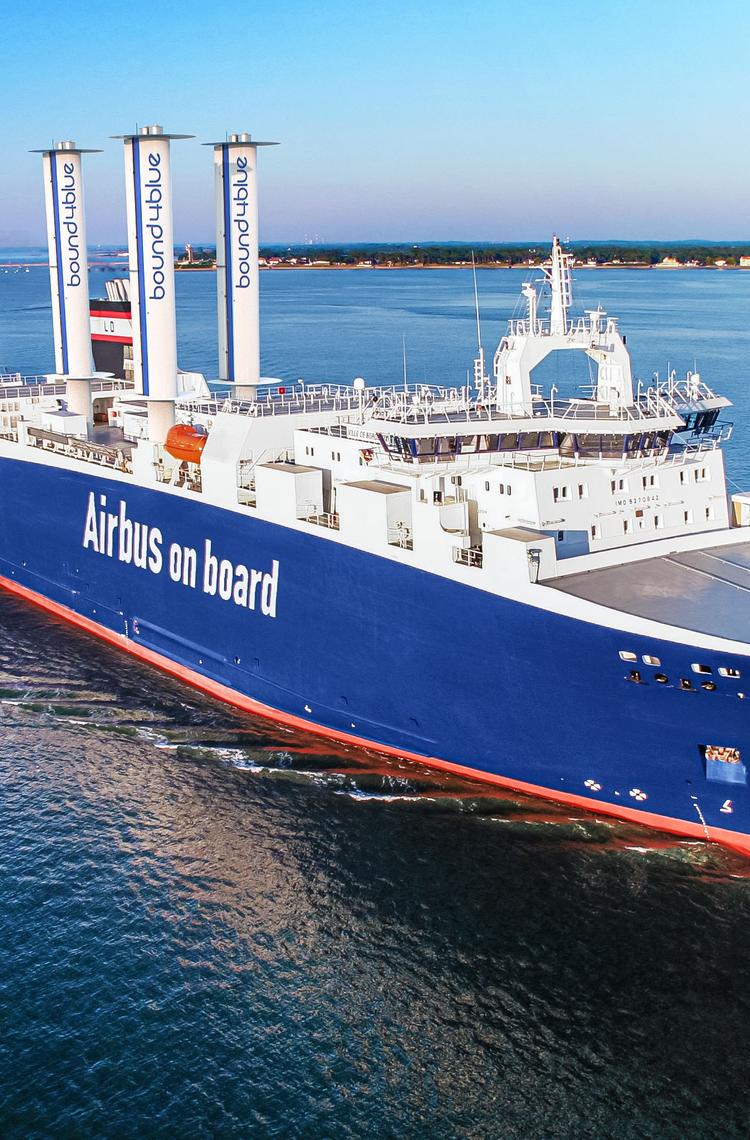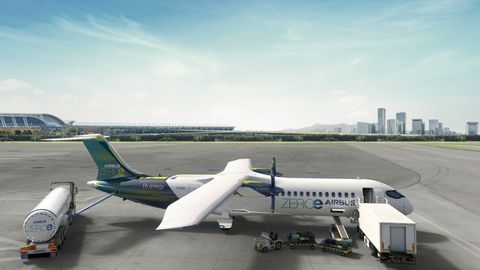Did you know Airbus transports some aircraft subassemblies by sea? In keeping with its purpose of pioneering sustainable aerospace and to support production ramp-up, the company is adopting innovative sail technology to help one of its chartered cargo vessels cross the Atlantic.
The Ville de Bordeaux, chartered from shipowner Louis Dreyfus Armateurs (LDA), regularly ferries A320 Family subassemblies from Europe to Mobile, Alabama, for final assembly.
LDA will equip the vessel with three eSAILs®. This autonomous suction sail system, developed by Barcelona-based firm bound4blue, is expected to deliver fuel and CO2 emissions savings of 560 tons and 1,800 tons respectively, compared to the Ville de Bordeaux’s current performance.* That’s the equivalent of over 700 diesel cars.** The reductions contribute to Airbus’ independently-validated Scope 1 & 2 industrial emissions targets.
Transatlantic Lift
The eSAIL® is a fully autonomous system that builds on the suction sail concept invented in the 1980s by the Jacques Cousteau Foundation. Looking a little like smoke stacks, the lightweight, 22 metre-high structures help push a ship along, partially relieving its main engines.
How do they work? The eSAIL® is a type of Wind-Assisted Propulsion System that uses suction to create lift. In fact the technique creates as much as six to seven times more lift than a conventional sail, with minimal power consumption and mechanical complexity.
The three eSAILs® will be fitted to the Ville de Bordeaux ahead of a six-month sea trial scheduled for the first quarter of 2024. Upon successful completion, they will be put to use on the Saint-Nazaire (France) - Mobile (US) crossing.
Extra capacity to support ramp-up
With operational sustainability in mind, the Ville de Bordeaux is also being fitted with a new elevator and upper cargo deck. The combination means the vessel can carry two additional single-aisle aircraft subassembly sets – wings, fuselage, engine pylons, horizontal and vertical tail planes – between Europe and the US. This brings to six the total number of sets that can be transported on each leg of the journey.
The extra capacity will reduce the number of crossings needed to support Airbus’ commercial aircraft production, which is aggressively ramping up in the United States, as it is elsewhere. Fewer crossings mean lower overall emissions, which are then further reduced by the adoption of bound4blue’s eSAILs®.
Fitting the eSAILs® to the Ville de Bordeaux is just a first step in meeting Airbus’ long-term ambition. Thanks to new, more efficient vessels entering its maritime fleet from 2026, by 2030 Airbus is committed to reducing CO2 emissions from its maritime operations by 50% compared to a 2015 baseline.
*Source: bound4blue
**Emissions over one year based on average fuel consumption of 6 litres/100 km
Discover more Sustainability news
Continue Reading

How Book and Claim enables SAF use for HEMS operations
Web Story
Helicopters
Airbus Helicopters and SAF Hélicoptères are using the Book and Claim system to support the accessibility of SAF for EMS missions in Catalonia.
Airbus fosters Barry Callebaut`s efforts to develop a deforestation-free supply chain
Press Release
Sustainability

Showcasing multiple decarbonisation levers at Dubai Airshow
Web Story
Sustainability
2024: The Airbus Foundation’s year in review
Web Story
Airbus Foundation

Saving the giant pangolins of Nyakweri Forest
Web Story
Airbus Foundation

